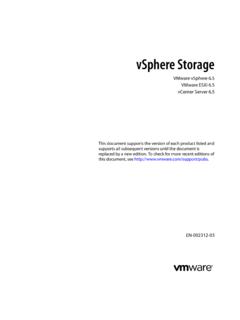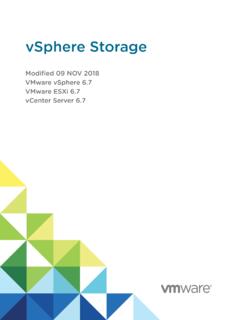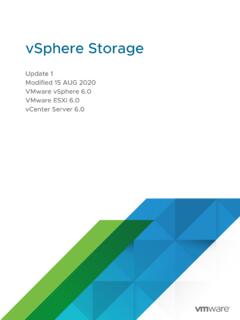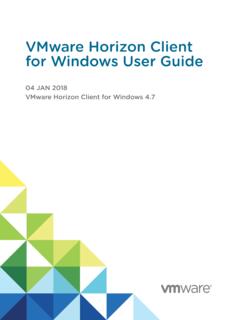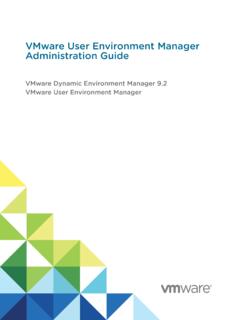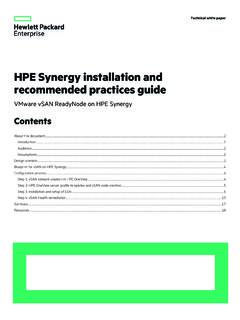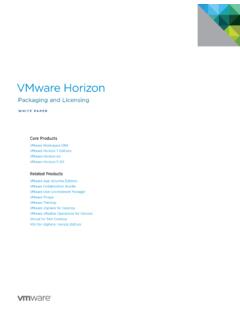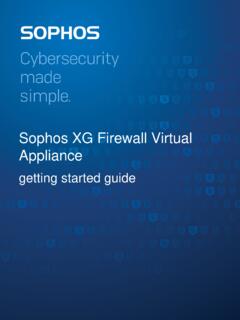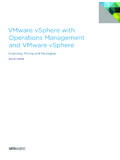Transcription of vSphere Storage - VMware vSphere 7
1 vSphere StorageModified on 15 AUG 2020 VMware vSphere ESXi Server can find the most up-to-date technical documentation on the VMware website at: , Hillview Alto, CA 2009-2020 VMware , Inc. All rights reserved. Copyright and trademark StorageVMware, vSphere Storage14 Updated Information151 Introduction to Storage16 Traditional Storage Virtualization Models16 Software-Defined Storage Models18vSphere Storage APIs192 Getting Started with a Traditional Storage Model20 Types of Physical Storage20 Local Storage20 Networked Storage21 Target and Device Representations 25 How Virtual Machines Access Storage26 Storage Device Characteristics27 Comparing Types of Storage30 Supported Storage Adapters31 View Storage Adapter Information31 Datastore Characteristics32 Display Datastore
2 Information34 Using Persistent Memory35 Monitor PMem Datastore Statistics373 Overview of Using ESXi with a SAN39 ESXi and SAN Use Cases40 Specifics of Using SAN Storage with ESXi41 ESXi Hosts and Multiple Storage Arrays41 Making LUN Decisions41 Use the Predictive Scheme to Make LUN Decisions42 Use the Adaptive Scheme to Make LUN Decisions42 Selecting Virtual Machine Locations43 Third-Party Management Applications44 SAN Storage Backup Considerations44 Using Third-Party Backup Packages454 Using ESXi with Fibre Channel SAN46 Fibre Channel SAN Concepts46 VMware .
3 In Fibre Channel SAN47 Fibre Channel Storage Array Types47 Using Zoning with Fibre Channel SANs48 How Virtual Machines Access Data on a Fibre Channel SAN485 Configuring Fibre Channel Storage50 ESXi Fibre Channel SAN Requirements50 ESXi Fibre Channel SAN Restrictions50 Setting LUN Allocations51 Setting Fibre Channel HBAs51 Installation and Setup Steps52N-Port ID Virtualization52 How NPIV-Based LUN Access Works52 Requirements for Using NPIV53 NPIV Capabilities and Limitations53 Configure or Modify WWN Assignments546 Configuring Fibre Channel over Ethernet56 Fibre Channel over Ethernet Adapters56 Configuration Guidelines for Software FCoE57 Set Up Networking for Software FCoE58 Add Software FCoE Adapters597 Booting ESXi from Fibre Channel SAN60 Boot from SAN Benefits60 Requirements and Considerations when Booting from Fibre Channel SAN 61 Getting Ready for Boot from SAN61 Configure SAN Components and Storage System62 Configure Storage Adapter to Boot from SAN63 Set Up Your System to Boot from Installation Media63 Configure Emulex HBA to Boot from SAN63
4 Enable the BootBIOS Prompt64 Enable the BIOS64 Configure QLogic HBA to Boot from SAN658 Booting ESXi with Software FCoE67 Requirements and Considerations for Software FCoE Boot67 Set Up Software FCoE Boot68 Configure Software FCoE Boot Parameters69 Install and Boot ESXi from Software FCoE LUN69 Troubleshooting Boot from Software FCoE for an ESXi Host70vSphere StorageVMware, Practices for Fibre Channel Storage71 Preventing Fibre Channel SAN Problems71 Disable Automatic ESXi Host Registration72 Optimizing Fibre Channel SAN Storage Performance72 Storage Array Performance73 Server Performance with Fibre Channel7310 Using ESXi with iSCSI SAN75 About iSCSI SAN75iSCSI Multipathing76 Nodes and Ports in the iSCSI SAN77iSCSI Naming Conventions77iSCSI Initiators78 About the VMware iSER Adapter79 Establishing iSCSI Connections79iSCSI Storage System Types80 Discovery, Authentication.
5 And Access Control 81 How Virtual Machines Access Data on an iSCSI SAN82 Error Correction8311 Configuring iSCSI Adapters and Storage84 ESXi iSCSI SAN Recommendations and Restrictions85 Configuring iSCSI Parameters for Adapters85 Set Up Independent Hardware iSCSI Adapters86 View Independent Hardware iSCSI Adapters87 Edit Network Settings for Hardware iSCSI88 Configure Dependent Hardware iSCSI Adapters89 Dependent Hardware iSCSI Considerations90 View Dependent Hardware iSCSI Adapters90 Determine Association Between iSCSI and Network Adapters91 Configure the Software iSCSI Adapter91 Activate or Disable the Software iSCSI Adapter92 Configure iSER Adapters93 Enable the VMware iSER Adapter94 View RDMA Capable Network Adapter95 Modify General Properties for iSCSI or iSER Adapters96 Setting Up Network for iSCSI and iSER97 Multiple Network Adapters in iSCSI or iSER Configuration98 Best Practices for Configuring Networking with Software iSCSI100 Configure Port Binding for iSCSI or iSER104 Managing iSCSI Network108vSphere StorageVMware.
6 Network Troubleshooting 108 Using Jumbo Frames with iSCSI109 Enable Jumbo Frames for Networking109 Enable Jumbo Frames for Independent Hardware iSCSI110 Configuring Discovery Addresses for iSCSI Adapters110 Configure Dynamic or Static Discovery for iSCSI and iSER on ESXi Host111 Remove Dynamic or Static iSCSI Targets111 Configuring CHAP Parameters for iSCSI Adapters112 Selecting CHAP Authentication Method112 Set Up CHAP for iSCSI or iSER Adapter113 Set Up CHAP for Target114 Configuring Advanced Parameters for iSCSI116 Configure Advanced Parameters for iSCSI on ESXi Host117iSCSI Session Management118 Review iSCSI Sessions118 Add iSCSI Sessions119 Remove iSCSI Sessions11912 Booting from iSCSI SAN121 General Recommendations for Boot from iSCSI SAN121 Prepare the iSCSI SAN122 Configure Independent Hardware iSCSI Adapter for SAN Boot123 Configure iSCSI Boot Settings12313 Best Practices for iSCSI Storage125 Preventing iSCSI SAN Problems125 Optimizing iSCSI SAN Storage Performance126 Storage System Performance126 Server Performance with iSCSI127 Network
7 Performance127 Checking Ethernet Switch Statistics13014 Managing Storage Devices131 Storage Device Characteristics131 Display Storage Devices for an ESXi Host132 Display Storage Devices for an Adapter133 Device Sector Formats134 Storage Device Names and Identifiers135 NVMe Devices with NGUID Device Identifiers137 Upgrade Stateless ESXi Hosts with NGUID-only NVMe Devices to Version Storage Devices140vSphere StorageVMware, Rescan Operations141 Perform Storage Rescan141 Perform Adapter Rescan142 Change the Number of Scanned Storage Devices142 Identifying Device Connectivity Problems143 Detecting PDL Conditions143 Performing Planned Storage Device Removal144 Recovering from PDL Conditions146 Handling Transient APD Conditions146 Verify the Connection Status of a Storage Device on ESXi Host148 Enable or Disable Locator LED on ESXi Storage Devices149 Erase Storage Devices149 Change Perennial Reservation Settings15015 Working with Flash Devices152
8 Marking Storage Devices153 Mark Storage Devices as Flash 153 Mark Storage Devices as Local154 Monitor Flash Devices154 Best Practices for Flash Devices155 Estimate Lifetime of Flash Devices155 About Virtual Flash Resource156 Considerations for Virtual Flash Resource 156 Set Up Virtual Flash Resource157 Remove Virtual Flash Resource158 Set Alarm for Virtual Flash Use159 Configure Host Cache with VMFS Datastore159 Keeping Flash Disks VMFS-Free16016 About VMware NVMe Storage161 VMware NVMe Concepts161 Basic VMware NVMe Architecture and Components163 Requirements and Limitations of VMware NVMe Storage165 Configure Adapters for NVMe over RDMA (RoCE v2) Storage167 Configure RDMA Network Adapters167 Enable Software NVMe over RDMA Adapters169 Add Controller for the NVMe over RDMA (RoCE v2)
9 Or FC-NVMe Adapter170 Remove the Software NVMe over RDMA Adapter17117 Working with Datastores173 Types of Datastores173vSphere StorageVMware, VMFS Datastores174 Versions of VMFS Datastores175 VMFS Datastores as Repositories177 Sharing a VMFS Datastore Across Hosts177 VMFS Metadata Updates178 VMFS Locking Mechanisms179 Snapshot Formats on VMFS183 Upgrading VMFS Datastores184 Understanding Network File System Datastores184 NFS Protocols and ESXi185 NFS Storage Guidelines and Requirements186 Firewall Configurations for NFS Storage190 Using Layer 3 Routed Connections to Access NFS Storage192 Using Kerberos for NFS Up NFS Storage Environment193 Configure ESXi Hosts for
10 Kerberos Authentication194 Creating Datastores197 Create a VMFS Datastore197 Create an NFS Datastore199 Create a vVols Datastore200 Managing Duplicate VMFS Datastores200 Mount a VMFS Datastore Copy201 Increase VMFS Datastore Capacity20

